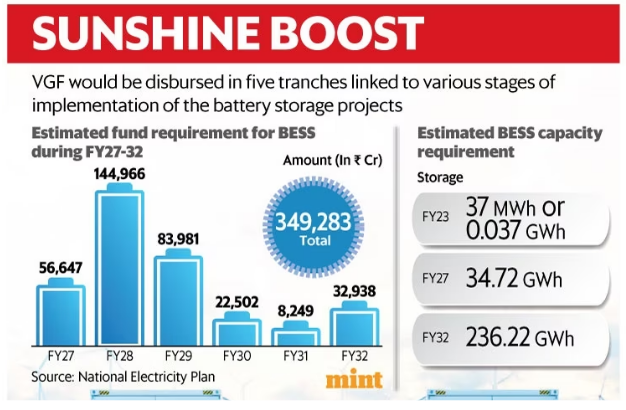Context:
The Union Cabinet, chaired by the Prime Minister approved the Scheme for Viability Gap Funding (VGF) for development of Battery Energy Storage Systems (BESS).
Key Features of Scheme for Viability Gap Funding (VGF):
Levelized Costs of Energy (LCOE):
- LCOE is a measure of the average present cost of electricity generation for a generating plant over its lifetime.
Viability Gap Finance:
- It means a grant to support projects that are economically justified but not financially viable.
Battery Energy Storage Systems:
- A battery energy storage system is a type of energy storage system that uses batteries to store and distribute energy as electricity.
- BESSs are often used to enable energy from renewable sources, like solar and wind, to be stored and released.
|
- Budgetary Outlay: An initial outlay of ₹9,400 crore, including a budgetary support of ₹3,760 crore.
- Aim:To reduce the levelized cost of storage (LCoS) to ₹5.50-6.60 per kilowatt-hour (kWh), making storage a viable option to manage peak power demand.
- To spur investments in Battery Energy Storage Systems (BESS) via viability gap funding.
- Funding: The VGF will be released in five tranches till 2030-31 and help in creation of 4,000 MWh storage across the country.
- The funding, which aims to reduce cost of energy storage for companies and consumers, is conditional to the fact that 85% of the BESS capacity will be made available to distribution companies (discoms).
- Selection of BESS developers: The selection of BESS developers for VGF grants will be carried out through a transparent competitive bidding process, promoting a level-playing field for both public and private sector entities.
- To ensure that the benefits of the scheme reach the consumers, a minimum of 85% of the BESS project capacity will be made available to power distribution companies (discoms).

Significance of Scheme:
- The scheme is in sync with India’s ambition to meet its 50% of energy requirements through renewable energy and non-fossil energy sources by 2030 and also help reduce carbon emission.
- It is expected to bring down the cost of battery storage systems increasing their viability.
- It will not only enhance the integration of renewable energy into the electricity grid but also minimize wastage while optimizing the utilization of transmission networks.
News Source: The Hindu
![]() 7 Sep 2023
7 Sep 2023

